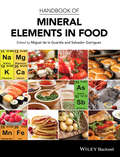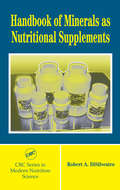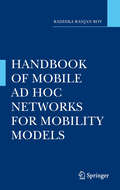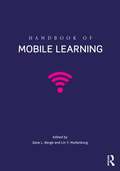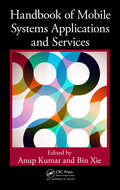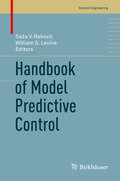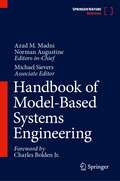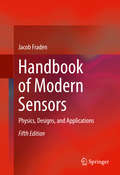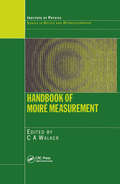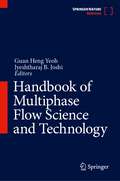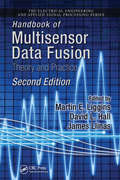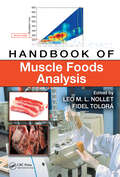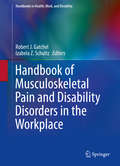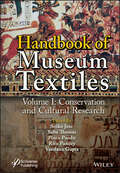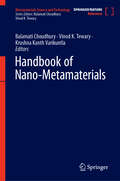- Table View
- List View
Handbook of Mineral Elements in Food
by Salvador Garrigues Miguel de la GuardiaMineral elements are found in foods and drink of all different types, from drinking water through to mothers' milk. The search for mineral elements has shown that many trace and ultratrace-level elements presented in food are required for a healthy life. By identifying and analysing these elements, it is possible to evaluate them for their specific health-giving properties, and conversely, to isolate their less desirable properties with a view to reducing or removing them altogether from some foods. The analysis of mineral elements requires a number of different techniques - some methods may be suitable for one food type yet completely unsuited to another. The Handbook of Mineral Elements in Food is the first book to bring together the analytical techniques, the regulatory and legislative framework, and the widest possible range of food types into one comprehensive handbook for food scientists and technologists. Much of the book is based on the authors' own data, most of which is previously unpublished, making the Handbook of Mineral Elements in Food a vital and up-to-the-minute reference for food scientists in industry and academia alike. Analytical chemists, nutritionists and food policy makers will also find it an invaluable resource. Showcasing contributions from international researchers, and constituting a major resource for our future understanding of the topic, the Handbook of Mineral Elements in Food is an essential reference and should be found wherever food science and technology are researched and taught.
Handbook of Minerals as Nutritional Supplements
by Robert A. DiSilvestroMineral supplements are receiving a great deal of attention and experiencing a tremendous period of growth. Despite their popularity, questions continue to arise regarding the research behind their claims, the efficacy of different forms, and their overall safety. It is critical for the health care community and the general public to have an unbias
Handbook of Mobile Ad Hoc Networks for Mobility Models
by Radhika Ranjan RoyThe Mobile Ad Hoc Network (MANET) has emerged as the next frontier for wireless communications networking in both the military and commercial arena. Handbook of Mobile Ad Hoc Networks for Mobility Models introduces 40 different major mobility models along with numerous associate mobility models to be used in a variety of MANET networking environments in the ground, air, space, and/or under water mobile vehicles and/or handheld devices. These vehicles include cars, armors, ships, under-sea vehicles, manned and unmanned airborne vehicles, spacecrafts and more. This handbook also describes how each mobility pattern affects the MANET performance from physical to application layer; such as throughput capacity, delay, jitter, packet loss and packet delivery ratio, longevity of route, route overhead, reliability, and survivability. Case studies, examples, and exercises are provided throughout the book. Handbook of Mobile Ad Hoc Networks for Mobility Models is for advanced-level students and researchers concentrating on electrical engineering and computer science within wireless technology. Industry professionals working in the areas of mobile ad hoc networks, communications engineering, military establishments engaged in communications engineering, equipment manufacturers who are designing radios, mobile wireless routers, wireless local area networks, and mobile ad hoc network equipment will find this book useful as well.
Handbook of Mobile Broadcasting: DVB-H, DMB, ISDB-T, AND MEDIAFLO
by Borko Furht Syed A. AhsonOperators are introducing mobile television and digital video content services globally. The Handbook of Mobile Broadcasting addresses all aspects of these services, providing a comprehensive reference on DVB-H, DMB, ISDB-T, and MediaFLO. Featuring contributions from experts in the field, the text presents technical standards and distribution proto
Handbook of Mobile Data Privacy
by Aris Gkoulalas-Divanis Claudio BettiniThis handbook covers the fundamental principles and theory, and the state-of-the-art research, systems and applications, in the area of mobility data privacy. It is primarily addressed to computer science and statistics researchers and educators, who are interested in topics related to mobility privacy. This handbook will also be valuable to industry developers, as it explains the state-of-the-art algorithms for offering privacy. By discussing a wide range of privacy techniques, providing in-depth coverage of the most important ones, and highlighting promising avenues for future research, this handbook also aims at attracting computer science and statistics students to this interesting field of research. The advances in mobile devices and positioning technologies, together with the progress in spatiotemporal database research, have made possible the tracking of mobile devices (and their human companions) at very high accuracy, while supporting the efficient storage of mobility data in data warehouses, which this handbook illustrates. This has provided the means to collect, store and process mobility data of an unprecedented quantity, quality and timeliness. As ubiquitous computing pervades our society, user mobility data represents a very useful but also extremely sensitive source of information. On one hand, the movement traces that are left behind by the mobile devices of the users can be very useful in a wide spectrum of applications such as urban planning, traffic engineering, and environmental pollution management. On the other hand, the disclosure of mobility data to third parties may severely jeopardize the privacy of the users whose movement is recorded, leading to abuse scenarios such as user tailing and profiling. A significant amount of research work has been conducted in the last 15 years in the area of mobility data privacy and important research directions, such as privacy-preserving mobility data management, privacy in location sensing technologies and location-based services, privacy in vehicular communication networks, privacy in location-based social networks, privacy in participatory sensing systems which this handbook addresses.. This handbook also identifies important privacy gaps in the use of mobility data and has resulted to the adoption of international laws for location privacy protection (e.g., in EU, US, Canada, Australia, New Zealand, Japan, Singapore), as well as to a large number of interesting technologies for privacy-protecting mobility data, some of which have been made available through open-source systems and featured in real-world applications.
Handbook of Mobile Learning
by Zane L. Berge Lin Y. MuilenburgThis handbook provides a comprehensive compendium of research in all aspects of mobile learning, one of the most significant ongoing global developments in the entire field of education. Rather than focus on specific technologies, expert authors discuss how best to utilize technology in the service of improving teaching and learning.
Handbook of Mobile Systems Applications and Services (Mobile Services And Systems Ser. #1)
by Bin Xie Anup KumarFrom fundamental concepts and theories to implementation protocols and cutting-edge applications, the Handbook of Mobile Systems Applications and Services supplies a complete examination of the evolution of mobile services technologies. It examines service-oriented architecture (SOA) and explains why SOA and service oriented computing (SOC) will pl
Handbook of Mobile Teaching and Learning
by Yu Aimee ZhangMobile technologies have been used in higher education for many years. They provide good solutions for teaching and learning and make learning available anywhere and anytime. This book includes six sections: design, development, adoption, collaboration, evaluation and future of mobile teaching and learning technology in higher education. It includes different projects and practices in higher education across different countries. The book provides in-depth background information and cases studies in high technology teaching and learning and future expectations for new technology in higher education. The variety of projects and programs running in different country helps boost innovation and discussion in future projects and practices. It also provide guidelines for future design and development of mobile applications for higher education.
Handbook of Model Predictive Control (Control Engineering)
by Saša V. Raković William S. LevineRecent developments in model-predictive control promise remarkable opportunities for designing multi-input, multi-output control systems and improving the control of single-input, single-output systems. This volume provides a definitive survey of the latest model-predictive control methods available to engineers and scientists today. The initial set of chapters present various methods for managing uncertainty in systems, including stochastic model-predictive control. With the advent of affordable and fast computation, control engineers now need to think about using “computationally intensive controls,” so the second part of this book addresses the solution of optimization problems in “real” time for model-predictive control. The theory and applications of control theory often influence each other, so the last section of Handbook of Model Predictive Control rounds out the book with representative applications to automobiles, healthcare, robotics, and finance. The chapters in this volume will be useful to working engineers, scientists, and mathematicians, as well as students and faculty interested in the progression of control theory. Future developments in MPC will no doubt build from concepts demonstrated in this book and anyone with an interest in MPC will find fruitful information and suggestions for additional reading.
Handbook of Model-Based Systems Engineering
by Azad M. Madni Michael Sievers Norman AugustineThis handbook brings together diverse domains and technical competences of Model Based Systems Engineering (MBSE) into a single, comprehensive publication. It is intended for researchers, practitioners, and students/educators who require a wide-ranging and authoritative reference on MBSE with a multidisciplinary, global perspective. It is also meant for those who want to develop a sound understanding of the practice of systems engineering and MBSE, and/or who wish to teach both introductory and advanced graduate courses in systems engineering. It is specifically focused on individuals who want to understand what MBSE is, the deficiencies in current practice that MBSE overcomes, where and how it has been successfully applied, its benefits and payoffs, and how it is being deployed in different industries and across multiple applications. MBSE engineering practitioners and educators with expertise in different domains have contributed chapters that address various uses of MBSE and related technologies such as simulation and digital twin in the systems lifecycle. The introductory chapter reviews the current state of practice, discusses the genesis of MBSE and makes the business case. Subsequent chapters present the role of ontologies and meta-models in capturing system interdependencies, reasoning about system behavior with design and operational constraints; the use of formal modeling in system (model) verification and validation; ontology-enabled integration of systems and system-of-systems; digital twin-enabled model-based testing; system model design synthesis; model-based tradespace exploration; design for reuse; human-system integration; and role of simulation and Internet-of-Things (IoT) within MBSE.
Handbook of Modern Hospital Safety
by William CharneyIt is ironic that those whose job it is to save lives often find themselves injured in the course of performing their duties. In fact, according to the Bureau of Labor Statistics, healthcare workers have higher injury rates than agriculture workers, miners, and construction workers. The Handbook of Modern Hospital Safety, Second Edition covers expo
Handbook of Modern Sensors
by Jacob FradenThe Handbook's coverage of sensors is extensive, ranging from simple photodiodes to complex devices containing components in combination. It offers hard-to-find reference data on the properties of numerous materials and sensing elements and emphasizes devices that are less well-known, whose technology is still being refined, and whose use permits the measurement of variables that were previously inaccessible.
Handbook of Modern Sensors: Physics, Designs, and Applications
by Jacob FradenThe Handbook's coverage of sensors is extensive, ranging from simple photodiodes to complex devices containing components in combination. It offers hard-to-find reference data on the properties of numerous materials and sensing elements and emphasizes devices that are less well-known, whose technology is still being refined, and whose use permits the measurement of variables that were previously inaccessible.
Handbook of Moire Measurement
by C. A. WalkerSince its development in the late 1970s, the Moire Fringe method has become a standard technique for the measurement of the behavior of materials and structures. Edited by one of the co-inventors of the technique, the Handbook of Moire Measurement brings together a series of extended case studies from recognized experts in the field. The emphasis i
Handbook of Molecular Gastronomy: Scientific Foundations, Educational Practices, and Culinary Applications
by Róisín M. BurkeHandbook of Molecular Gastronomy: Scientific Foundations and Culinary Applications presents a unique overview of molecular gastronomy, the scientific discipline dedicated to the study of phenomena that occur during the preparation and consumption of dishes. It deals with the chemistry, biology and physics of food preparation, along with the physiology of food consumption. As such, it represents the first attempt at a comprehensive reference in molecular gastronomy, along with a practical guide, through selected examples, to molecular cuisine and the more recent applications named note by note cuisine. While several books already exist for a general audience, either addressing food science in general in a "light" way and/or dealing with modern cooking techniques and recipes, no book exists so far that encompasses the whole molecular gastronomy field, providing a strong interdisciplinary background in the physics, biology and chemistry of food and food preparation, along with good discussions on creativity and the art of cooking. Features: Gives A–Z coverage to the underlying science (physics, chemistry and biology) and technology, as well as all the key cooking issues (ingredients, tools and methods). Encompasses the science and practice of molecular gastronomy in the most accessible and up-to-date reference available. Contains a final section with unique recipes by famous chefs. The book is organized in three parts. The first and main part is about the scientific discipline of molecular and physical gastronomy; it is organized as an encyclopedia, with entries in alphabetical order, gathering the contributions of more than 100 authors, all leading scientists in food sciences, providing a broad overview of the most recent research in molecular gastronomy. The second part addresses educational applications of molecular gastronomy, from primary schools to universities. The third part provides some innovative recipes by chefs from various parts of the world. The authors have made a particular pedagogical effort in proposing several educational levels, from elementary introduction to deep scientific formalism, in order to satisfy the broadest possible audience (scientists and non-scientists). This new resource should be very useful to food scientists and chefs, as well as food and culinary science students and all lay people interested in gastronomy.
Handbook of Molecular Lasers (Optical Science and Engineering)
by Peter K. CheoOptical science, engineering, and technology have grown rapidly in the last decade so that today optical engineering has emerged as an important discipline in its own right. This series is devoted to discussing topics in optical engineering at a level that will be useful to those working in the field or attempting to design systems that are based on optical techniques or that have significant optical subsystems.
Handbook of Multiphase Flow Science and Technology
by Guan Heng Yeoh Jyeshtharaj B. JoshiThis Handbook provides readers with the current cutting edge of multiphase flow technology. It reviews the rapid development of multiphase flow technology, demonstrates the latest development of the technology and showcase the very latest applications. It provides readers with comprehensive updated reference information covering theory, modelling and numerical methods, design and measurement, and new applications in multiphase flow systems.The Handbook consists of three parts or volumes:1. Theory: describes the fundamentals including the concepts and definitions of multiphase flows. Classifications of multiphase flows. Basic understanding of different length scales involved – micro/nano, meso and macro. Treatment of such flows by different solution frameworks.2. Modelling and Measurement: covers both classical and state-of the-art measurement and modelling approaches to resolve different classifications of multiphase flows. 3. Applications: highlights the very latest applications of measurement and modelling approaches in tackling different classification of multiphase flows in a variety of natural, biological and industrial systems and different length scales.
Handbook of Multiphase Polymer Systems
by Sabu Thomas Laurent Ibos Abderrahim Boudenne Yves CandauMultiphase polymeric systems include a wide range of materials such as composites, blends, alloys, gels, and interpenetrating polymer networks (IPNs). A one-stop reference on multiphase polymer systems, this book fully covers the preparation, properties, and applications of advanced multiphase systems from macro to nano scales. Edited by well-respected academics in the field of multiphase polymer systems, the book includes contributions from leading international experts. An essential resource for plastic and rubber technologists, filler specialists and researchers in fields studying thermal and electrical properties.
Handbook of Multisensor Data Fusion: Theory and Practice (Second Edition) (Electrical Engineering & Applied Signal Processing Series)
by David Hall James Llinas Martin Liggins IIIn the years since the bestselling first edition, fusion research and applications have adapted to service-oriented architectures and pushed the boundaries of situational modeling in human behavior, expanding into fields such as chemical and biological sensing, crisis management, and intelligent buildings. Handbook of Multisensor Data Fusion: Theory and Practice, Second Edition represents the most current concepts and theory as information fusion expands into the realm of network-centric architectures. It reflects new developments in distributed and detection fusion, situation and impact awareness in complex applications, and human cognitive concepts. With contributions from the world’s leading fusion experts, this second edition expands to 31 chapters covering the fundamental theory and cutting-edge developments that are driving this field. New to the Second Edition— · Applications in electromagnetic systems and chemical and biological sensors · Army command and combat identification techniques · Techniques for automated reasoning · Advances in Kalman filtering · Fusion in a network centric environment · Service-oriented architecture concepts · Intelligent agents for improved decision making · Commercial off-the-shelf (COTS) software tools From basic information to state-of-the-art theories, this second edition continues to be a unique, comprehensive, and up-to-date resource for data fusion systems designers.
Handbook of Multivariate Process Capability Indices
by Ashis Kumar Chakraborty Moutushi ChatterjeeProviding a single-valued assessment of the performance of a process is often one of the greatest challenges for a quality professional. Process Capability Indices (PCIs) precisely do this job. For processes having a single measurable quality characteristic, there is an ample number of PCIs, defined in literature. The situation worsens for multivariate processes, i.e., where there is more than one correlated quality characteristic. Since in most situations quality professionals face multiple quality characteristics to be controlled through a process, Multivariate Process Capability Indices (MPCIs) become the order of the day. However, there is no book which addresses and explains different MPCIs and their properties. The literature of Multivariate Process Capability Indices (MPCIs) is not well organized, in the sense that a thorough and systematic discussion on the various MPCIs is hardly available in the literature. Handbook of Multivariate Process Capability Indices provides an extensive study of the MPCIs defined for various types of specification regions. This book is intended to help quality professionals to understand which MPCI should be used and in what situation. For researchers in this field, the book provides a thorough discussion about each of the MPCIs developed to date, along with their statistical and analytical properties. Also, real life examples are provided for almost all the MPCIs discussed in the book. This helps both the researchers and the quality professionals alike to have a better understanding of the MPCIs, which otherwise become difficult to understand, since there is more than one quality characteristic to be controlled at a time. Features: A complete guide for quality professionals on the usage of different MPCIs. A step by step discussion on multivariate process capability analysis, starting from a brief discussion on univariate indices. A single source for all kinds of MPCIs developed so far. Comprehensive analysis of the MPCIs, including analysis of real-life data. References provided at the end of each chapter encompass the entire literature available on the respective topic. Interpretation of the MPCIs and development of threshold values of many MPCIs are also included. This reference book is aimed at the post graduate students in Industrial Statistics. It will also serve researchers working in the field of Industrial Statistics, as well as practitioners requiring thorough guidance regarding selection of an appropriate MPCI suitable for the problem at hand.
Handbook of Muscle Foods Analysis
by Fidel Toldrá Leo M.L. NolletIn today's nutrition-conscious society, there is a growing awareness among meat scientists and consumers about the importance of the essential amino acids, vitamins, and minerals found in muscle foods. Handbook of Muscle Foods Analysis provides a comprehensive overview and description of the analytical techniques and application methodologies for t
Handbook of Musculoskeletal Pain and Disability Disorders in the Workplace
by Izabela Z. Schultz Robert J. GatchelThis book addresses the complexity of preventing, diagnosing, and treating musculoskeletal pain and disability disorders in the workplace. Divided evenly between common occupational pain disorders, conceptual and methodological issues, and evidence-based intervention methods, this comprehensive reference presents current findings on prevalence, causation, and physical and psychological aspects common to these disorders. Attention is given to working-world concerns, including insurance and compensation issues and AMA guidelines for disability evaluations. Also, specialized chapters offer lenses for understanding and administering the best approaches for treating specific pain disorders, and explore what workplaces can do to accommodate affected employees and prevent injuries from occurring in the first place.
Handbook of Museum Textiles, Volume 1: Conservation and Cultural Research
by Sabu Thomas Pintu Pandit Vandana Gupta Seiko Jose Ritu PandeyHandbook of Museum Textiles Textiles have been known to us throughout human history and played a vital role in the lives and traditions of people. Clothing was made by using different materials and methods from natural fibers. There are different varieties of textiles, out of which certain traditional textiles, archaeological findings, or fragments are of cultural, historical, and sentimental value such as tapestries, embroideries, flags, shawls, etc. These kinds of textiles, due to their historical use and environmental factors, require special attention to guarantee their long-term stability. Textile conservation is a complex, challenging, and multi-faceted discipline and it is one of the most versatile branches of conservation. Volume 1 of the Handbook of Museum Textiles focuses on conservation and cultural research and addresses the proper display, storage, upkeep, handling, and conservation technology of textile artifacts to ensure their presence for coming generations. Spread over 19 chapters, the volume is a unique body of knowledge of theoretical and practical details of museum practices. Chapters on textile museums, the importance of cultural heritage, conservation, and documentation of textiles are covered in depth. Conservation case studies and examples are highlighted in many chapters. Management practices and guidelines to pursue a career in the museum textile field have been given due attention. The respective authors of the chapters are of international repute and are researchers, academicians, conservators, and curators in this field. Audience The book is a unique asset for textile researchers, fine art scholars, archaeologists, museum curators, designers, and those who are interested in the field of traditional or historic textile collections.
Handbook of Museum Textiles, Volume 2: Scientific and Technological Research
by Sabu Thomas Pintu Pandit Seiko Jose Ritu PandeyHandbook of Museum Textiles Textiles have been known to us throughout human history and played a vital role in the lives and traditions of people. Clothing was made by using different materials and methods from natural fibers. There are different varieties of textiles, out of which certain traditional textiles, archaeological findings, or fragments are of cultural, historical, and sentimental value such as tapestries, embroideries, flags, shawls, etc. These kinds of textiles, due to their historical use and environmental factors, require special attention to guarantee their long-term stability. Textile conservation is a complex, challenging, and multi-faceted discipline and it is one of the most versatile branches of conservation. Volume II of the Handbook of Museum Textiles provides precise instruction for conservation techniques to preserve the textile heritage more scientifically and technologically. Additionally, the book covers the most modern techniques used to characterize archaeological textiles and dyes. Progress and innovation in nanotechnology-based interventions in museum textiles are emphasized. Chapters cover the general introduction to biological damage caused by physical and chemical agents and their prevention methods. Information on microscopy and characterization of historical textiles, ancient dyes, and prints is highlighted. Several aspects of assessment of degradation, repair, and stabilization of antique textiles are presented in depth. Experimental research methods for diagnosis and scientific study of fibers and natural dyes using LC-MS and UV-VIS are described. Practical knowledge based on analysis and visualization of historical textiles for the needs of museum conservation, exhibition, digital technology, and virtual museums is addressed as well. Audience It will serve as an educational asset and tool for researchers, art scholars, archaeologists, museum curators, and those who are interested in the field of traditional or historic textile collections.
Handbook of Nano-Metamaterials (Metamaterials Science and Technology #1)
by Balamati Choudhury Vinod K. Tewary Krushna Kanth VarikuntlaThis handbook is intended to serve as a comprehensive reference work on nano-metamaterials. The book covers an array of topics on nano-metamaterials, from theoretical modeling to fabrication and from measurement techniques to applications. The book comprises contributions by pioneers and leaders in the field of nanotechnology aspects of metamaterials. This volume is part of a larger reference series covering all aspects of metamaterials science and technology. The contents of this volume will be of use to researchers in academia and critical industrial sectors, such as aerospace, satellite communications, and defense.
